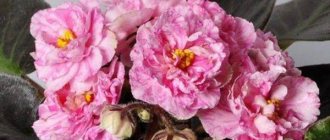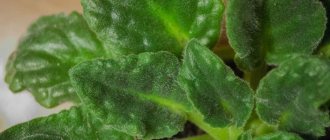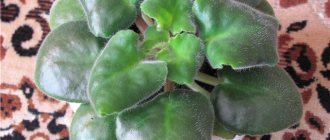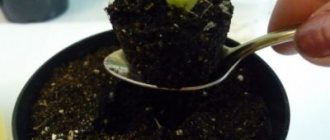Why are violets crossed?
Flower growers cross violets, wanting to get new varieties that are not yet in the home collection. But this work requires a lot of experience and knowledge.
OLYMPUS DIGITAL CAMERA
Everything is not as simple as it might seem at first glance. The selection of violets begins with:
- determining the goal: the desired color of buds, leaves and other characteristics;
- choosing healthy parents;
- breeding a variety that was previously unknown.
Even painstaking work does not guarantee results, since it is difficult for a gardener without a biological education to guess which characteristics will prevail in the bred Saintpaulia. The transfer of characteristics from a selected pair to a new plant is based on the interaction of recessive and dominant traits. So, if you cross a purple flower with a pink one, the new variety will have blue and purple petals. If you independently pollinate a pair with shaggy and simple buds, there is a high probability of getting a Saintpaulia with smooth flowers.
Characteristics of the houseplant Saintpaulia
The Saintpaulia flower, or Uzambara violet, is one of the most popular flowering houseplants. Low (15-20 cm) evergreen perennial herbaceous stemless plant.
The leaves of Saintpaulia are predominantly round, pubescent, brittle, on short petioles, collected in beautiful rosettes. The flowers are simple and double, with corrugated or wavy petals. The color is very diverse - white, pink, blue, blue, red, yellow. The flowers are collected in few-flowered inflorescences, sitting on peduncles of varying lengths. They appear almost continuously, at almost any time of the year, from the axils of the upper and middle leaves.
Blooms all year round.
Hybrid forms are very diverse. Thus, large varieties of Saintpaulia reach a diameter of 40 cm or more. Ordinary plants most often have a diameter of 20 to 40 cm, and miniature ones are only 7.5-15 cm. In addition, there are variations of intermediate size and subminiature, with an adult rosette diameter of less than 7.5 cm.
The foliage does not tolerate contact with water. To prevent the leaves and numerous flowers from getting wet, Saintpaulia naturally lives in cracks and crevices of rocks.
The wide variety of flower colors and shapes is the result of the introduction of genes from other species, although the original species is not grown as a houseplant.
There is a huge selection of varieties, varying in color, flower shape and growth habit, making Saintpaulias ideal plants for collectors. If you provide them with the right lighting, you can get the plant to bloom all year round. When starting to grow this attractive plant, keep in mind that most Saintpaulias from flower shops do not have special names, and only by contacting special nurseries, you can find hundreds of varieties, each of which will have its own name.
Look at the photo - semi-double Saintpaulia flowers have more than five petals, but yellow anthers are visible in the center:
Double flowers have at least ten petals and the anthers in the center are not visible. The ruffled flowers have petals with a wavy edge. Star-shaped flowers have five petals of equal size, as opposed to the more common flowers with two small and three large petals.
When describing Saintpaulias, they always note the amazing variety of colors of the perianths: they can be white, pink, red, blue, indigo, violet, with spots, stripes, or with a border of a different color.
In apartments, ampelous types of Saintpaulia are often used for landscaping. Ampel plants have more voluminous foliage, their stems fall, hanging over the edge of the pot, presenting a wonderful living picture. Saintpaulias are used to decorate the interior of kindergartens, schools, and offices. They look great in flower arrangements.
Types and varieties. Currently, there are several hundred varieties, mainly derived from Saintpaulia violet (S. ionantha). There is no point in listing varieties. Now you can buy violets for every taste, both domestic and foreign varieties.
Breeding methods at home
Violet selection is carried out using self-pollination. To do this, select a healthy pair of flowers to obtain the desired color. Pollen from the anther of another specimen is applied to the pistil of 1 plant using a needle. Pollen ripens 5 days after the bud opens. The pistil is ready for pollination after a drop of liquid appears on its surface.
After crossing, the formation of a box with seeds similar to dark brown dust will begin. The seed will be fully ripe in six months. By this time, the stem will dry out and the box can be easily separated from the bush. It is opened with a needle, the seeds are taken out and dried at room temperature. They are ready for planting 2-3 weeks after ripening. Germination lasts up to 6 months.
Leaves
Saintpaulia easily propagates from a leaf under the inflorescence. It is enough to break it off or cut it and place it in boiled water with the addition of 1 tablet of activated carbon. Or you can immediately plant the leaf in the soil mixture and wait for roots to take root. It is recommended to transplant sprouts into a pot when the roots are 1-2 cm long. Such propagation is used for sale. When divided by a leaf, the new plant will take on all the characteristics of the mother plant. But this does not happen with all types of Saintpaulia.
Violets are not crossed using castings, but some varieties, when propagated by cuttings, can obtain a different color of buds and foliage.
Saintpaulia chimeras from a leaf do not look like the mother flower. Here there is room for the imagination of a violet breeder to run wild. To propagate the chimera, it is impossible to use leaf cuttings; dividing the bush or rooting violet flower stalks with 2 small leaves is a more suitable option. Stepchildren appear in the axils of the leaves. To stimulate their growth, cut off the top of the plant.
Up to 20% of new plants from a fantasy violet bush also do not repeat the characteristics of an adult plant. Each leaf can produce a bush of a different color. Therefore, leaves can also be used to select fantasy violets.
Is cross-pollination possible?
Theoretically, Saintpaulia can pollinate itself, but in practice this rarely happens. Violets can cross-pollinate if there is an air conditioner or fan nearby, a cat wanders near the flower, or the pot is in a strong draft. In these cases, action must be taken. After all, when white and purple Saintpaulia are in close proximity, a plant with pink petals is obtained.
Cross-pollination most often occurs when 2 types of violets are grown in 1 pot at once. If they are not transplanted in time, then instead of 2 different flowers the owner will receive 1 plant, and it will be difficult to guess its future color.
Correct planting material: how to grow a flower from a violet leaf
Many people want to grow violets on their windowsill because of their attractive appearance and abundant, magnificent flowering, which is so pleasing to the eye of any gardener. However, many people think that this plant is overly capricious, so not everyone will be able to grow and care for it so that it remains healthy. In fact, the violet is quite unpretentious, it does not like excessive watering and frequent movements, but otherwise it does not need much, and it reproduces plants quickly and easily, so it will not be difficult to cope if desired.
Important
You need to know that growing violets from leaves is a long and painstaking process that will only be successful if the planting material is selected correctly. Ninety percent of success depends on this, according to experienced breeders. If the leaf is weak or, even more so, sick, then the plant will grow stunted and frail, if it grows at all.
Flower growers often give special recommendations for growing violets from leaves, and by following them you can really simplify your work significantly and also get an excellent result in the form of a lush, healthy plant. It makes sense for us to listen to what experienced people say about planting material:
- For planting violets, it is best not to choose the lowest leaves of the plant, just those that are closest to the ground. The fact is that it is there that they may turn out to be weak and unhealthy, or be affected by pests or diseases. Bacteria and fungi are what threaten violets, and they begin their dirty deeds from the bottom, from the lowest tiers of the plant.
- It is advisable to take the second or third leaf, which will already be stronger and also protected from pests, mold and fungi by the first tiers. They are usually well formed and have pronounced turgor.
- It is best to use healthy ones for propagation, without cracks, scratches, drying out or burn spots.
- If you are trying to plant variegated violets with leaves, then select only those leaves that have calm, maximum green shades, without spots.
- If you did not personally pick the leaves for planting, but sent them to you by mail, or they simply waited a long time in the wings, then before planting they need to be brought to life, that is, simply put in warm water with potassium permanganate previously diluted in it. You need to make sure that the water is boiled and the solution of potassium permanganate is very weak, literally a few crystals.
It is worth understanding that when the leaf regains its strength, it will take time, at least a couple of hours, after which the planting material must be pulled out and the stalk carefully cut with sharp scissors three to four centimeters from the leaf plate.
Rooting in soil mixture
For planting seeds or rooting leaf cuttings of Saintpaulia varieties of chimera or fantasy, a special substrate is used. Loose, breathable soil is best suited for violets. Soil from the garden is not suitable for growing flowers. It may be unsuitable in terms of acidity and density. It is advisable to plant the flower in a slightly acidic environment.
You can purchase a ready-made substrate at a flower shop or prepare it yourself. To do this, take 1 part of leaf humus, washed sand, moss and turf soil from the garden bed, 0.5 - perlite or charcoal, 3 - peat. Perlite or charcoal is added to disinfect and maintain optimal humidity levels.
For planting seeds or leaves, a small pot with a diameter of 4 cm and holes in the bottom for drainage is suitable. Over time, grown sprouts are transplanted into larger containers, but only after the young plant is twice the size of the container.
There are 2 ways to root leaf cuttings: in soil and water. For the first method, the cut leaf is dipped in a manganese solution and deepened 1.5 cm into the soil. It is advisable to place the pot in a warm, sunny place and protect it from drafts. You can cover it with a jar or a transparent plastic bag. Water the cuttings only after the top layer of the substrate has dried. In the second option, the leaf is transferred to the ground when it has already sprouted small roots.
When planting seeds, they are mixed with fine-grained sand and sown. There is no need to cover with a layer of soil. Place the container with soil in a well-lit place. Cover the top with glass, which should be lifted periodically to ventilate the surface of the substrate. It is recommended to constantly irrigate the soil and ensure that it does not dry out. Already grown shoots are transplanted into a separate container.
Breeding from peduncles and stepsons
These methods are suitable for chimeric varieties, since when propagated by leaf blades, the children do not take on the color of the parent plant.
Breeding by stepson
The stepsons formed in the axils of the violets are carefully separated. Their length must be at least 4 cm. Then they are rooted in soil or water according to the same pattern as when propagated by leaves. When the young plants grow a little, they can be planted in small flower pots. Transplantation is done only by transshipment method.
To do this, the earthen ball is placed together with the plant in a new pot. After some time you can expect the first flowering. If the violets are chimeric, then the first time they bloom is not as beautiful as in subsequent seasons, so do not be upset if the flowers are not so beautiful and lush.
Propagation by peduncles
Chimera violets are also usually propagated in this way. On a violet, select a peduncle that has bloomed or just faded and cut it off with a sharp tool. Rooting of the peduncle is done in a substrate consisting of moss or perlite. The substrate is constantly kept moist. A greenhouse is built over the container. A sure sign that rooting has occurred will be the appearance of a new rosette. And when it grows a little, you can transplant the plant into a flower pot.
Caring for violets after propagation
Caring for young shoots is similar to caring for adult Saintpaulias. After rooting, it is advisable to lower the ambient temperature from +27°C to +20...+22°C. Humidity should be maintained at 50%. Daylight hours for proper development of sprouts should be 12-14 hours. In winter, the shoots are illuminated with fluorescent lamps.
A young plant needs more frequent irrigation. When watering, you need to make sure that drops of water do not fall on the leaves. If this happens, rot may form. It is best to water the shoots through a tray. They pour water into it and wait until the moisture leaves. The remains are drained.
More perlite or coal is added to the soil for transplanting sprouts to prevent rotting of the root system, which is not yet fully formed.
Possible difficulties
The most common questions about indoor violets are related to the lack of flowering, yellowing of foliage and leaf spotting.
- If your violet does not bloom, then, in addition to pests, there may be a number of reasons for this: lack of light, short daylight hours, excess nitrogen fertilizing, excessive amounts of moisture in the soil or lack of it in the air. This problem is also caused by a large growing container and an excessively dense substrate.
- Yellowing of the leaves may indicate aging of the flower. This also occurs when placed in direct sunlight. This can be observed when the soil acidity deviates from the norm, as well as when there is an excess of phosphorus fertilizers.
- Most often, spots on leaves are the result of pests and diseases, but sometimes they appear due to drafts.
- Spots on the edges of the leaves indicate a lack of potassium in the soil - which means the substrate has become depleted and it’s time to replant the flower.
- Dry spots form if the violet is exposed to direct sunlight.
Buying violet flowers: how to choose the right perennial cultivated plants
Currently, flower growers do not face the problem of purchasing violet seeds or ready-made planting material (unless, of course, we are talking about rare varieties or species that are little used in cultivation).
You just need to figure out which species are suitable for the conditions of your garden and which varieties will most successfully combine in habit and color scheme with other participants in a particular flower arrangement.
Perennial violet flowers can most often be purchased in stores and garden centers in the form of ready-made planting material: well-developed plants (often flowering), grown in plastic containers or pots.
When purchasing such plants, pay attention to the label indicating the type and its basic requirements for cultivation conditions. If such data is not available, contact the sellers for clarification or look at the company’s catalog or other reference literature.
Before buying violets, make sure that the plants are not wilted or yellowed, and that there are no spots or other signs of damage from diseases or pests on the leaves.
If, after purchasing plants in containers, you do not have the opportunity to immediately plant them in a permanent place, then place them in a shaded place and water them moderately until planting.
Some types of perennial violet plants can be purchased from hobbyists - flower growers, plant collectors or in botanical gardens. In such cases, as a rule, bushes or divisions (part of a bush) with an open root system are purchased, so it is important to take into account the phase of plant development.
For the most part, perennial violets tolerate dividing bushes and replanting well throughout the growing season, but the most favorable periods for replanting are the period when leaves begin to grow in the spring (mid-April) and the second half of summer, after flowering has ended and the seeds have ripened.
How to choose the right violets?
When purchasing such plants, it is necessary to ensure that the soil in which the dug plants sit is moist and the leaves are not withered. All shoots should have a well-developed root lobe.
The cuttings must be immediately packed in plastic bags or boxes and watered moderately, preventing the roots from drying out. Such planting material should be planted in the ground as soon as possible.
For some types of violas, a lot of time passes between sowing seeds and the appearance of seedlings, so if you still have not seen seedlings a month after sowing, do not get upset and do not throw the soil out of the seed box, but just be patient.
Sometimes you can buy seeds of some species in stores. If you are already familiar with the description of violet plants, carefully read the recommendations for their cultivation, since the seeds of some species require special conditions when sowing: stratification (freezing), scarification (breaking the seed coat), etc.
Often, lovers of herbaceous plants dig up their favorite violets directly from “nature.” Many ecologists and botanists categorically do not recommend doing this, so as not to impoverish wildlife.
If you nevertheless decide to transfer a plant from a forest or meadow to a garden, do it carefully, taking it from places where there is a significant concentration of this species, and in very small quantities, so as not to disturb the existing ecological system in that place.
Below you will receive tips for choosing annual biennial violets.
Violet Greenhouse Effect (K. Morev)
Violet Greenhouse Effect belongs to the genus of hybrids.
Systematic position
Order: Clear-flowered (Lamiáles).
Family: Gesneriaceae.
Genus: Hybrid Saintpaulia (Saintpaulia hybrida).
Description of appearance
Original variety. Unusual white single or semi-double bells. The edge of the petals is corrugated. The color of the border ranges from light green to light brown.
The leaves are medium green. Rosette of this violet:
- Neat;
- Dense;
- Sometimes it grows very large.
The fused petals of the flowers form a jug with a strongly corrugated edge turned outward.
IMPORTANT! The flower size does not exceed 4-5 cm.
Seed propagation
This is the most complex and labor-intensive process of growing violets, which is used at home. It is usually used by experienced flower growers involved in the selection of violets, since propagation using seeds makes it possible to develop a new variety.
First, parental violets are selected that will be used for breeding. They must be healthy, well developed and strong. For crossing, pollen is carefully collected and the pistils are pollinated with it. This should be done when wet drops appear on the pistils. To increase the likelihood of success, it is better to pollinate several flowers on a peduncle at once.
Approximately 30 days after pollination, seed pods will appear. They are not harvested immediately, but wait about another four months for them to ripen. After they become dry and hard, they are collected and placed in a warm place with dry air for several days. Then the seeds can be sown. To do this, a box or other large container is filled with perlite, the seeds are mixed with sand for uniform sowing and sown in the ground on the surface.
There is no need to sprinkle or deepen them, but after sowing they need to be sprinkled with water. The container is placed under a glass greenhouse and ventilated daily and the condensation is removed. Fluorescent lamps are installed as additional lighting. After the seedlings grow to 0.5 cm, they can be planted in separate pots and grown like all violets.
What do violet seeds look like?
Like all flowering plants, violet seeds ripen in the fruit, which is a capsule filled with seeds. The seeds are very small, black, covered with shiny skin.
Round-shaped fruits can contain up to 100 seeds, the largest boxes contain up to 200 seeds , the smallest of them are in subulate-shaped boxes. Look at the photo below to see what the seeds of indoor violets look like.
Green and ripe boxes.
In apartment conditions, flower pollination does not occur , so violets do not produce fruits and seeds. In this case, the flower must be pollinated artificially.
Tell us about your color preferences
It’s a paradox, but I love relatively large decorative foliage plants. In my bedroom I have a sort of mini-winter garden with a “curtain”. There is a huge variegated ficus there, with a trunk 7 cm thick, which I periodically cut off, because the branches rest against the ceiling; two types of crotons - a tree, with a thick trunk, with leathery leaves of all rainbow shades, with clearly traced yellow-brown veins, and a bush, with beautiful yellow-lemon-green plates; and a very, very old 30-year-old, half-human-sized, spaphytiphyllum. He is the first plant I bought. As a minor, he went from Zhukovsky to Moscow, the only one in high esteem who moved between three Moscow apartments. I don’t know what its “name” is, since I transplanted 4 or 5 different species into one pot and forgot all the names. This winter garden will remain forever, because this is my Youth.
What do indoor violet seeds look like?
First of all, it is worth buying high-quality seed material. Many beginners, and sometimes even advanced gardeners, do not pay proper attention to this stage and ultimately remain dissatisfied with the result. First you need to purchase a seed pod, but not at the market, but in a specialized store or at a flower exhibition.
The Saintpaulia pestle should be cleaned. Then use a needle to open the box. Ideally, there should be a lot of seeds, but sometimes unscrupulous suppliers do not provide the plant with proper care, as a result of which movra is born in small quantities. Very often sellers use different tricks, so you should be careful when choosing and purchasing, especially on the Internet.
A normal moura will look like this:
- tiny, resembles grains of sand, but don’t worry, because this is the norm;
- has a limited range of colors, from black to brown;
- oblong, looks like small coffee granules with pointed ends.
Distinctive features of care
Need to know! For a comfortable existence and development of very beautiful flowers, you need to take care of creating the necessary conditions and following the rules of care.
- Lighting.
This Saintpaulia loves light, but not direct light. The pot with the plant is placed on the east or west window. Shading should be done on the south window. A pot of violets should not be placed deep into the room, because there will not be enough light, which will lead to a slowdown in the development of Saintpaulia. - Temperature.
An adult Saintpaulia requires a temperature in the range of 20 - 23 degrees. Young people need warmer air - 23 - 25 degrees. Temperature changes during the day should be 2 - 3 degrees. It works best when the temperature is the same.At night, an increase in temperature harms the plant, since at this time tissue respiration is at its maximum level. A low temperature of 15 degrees and an excessively high temperature of 30 degrees leads to the fact that Saintpaulia does not grow and leads to deformation of the foliage and flower.
- Humidity.
Suitable room humidity for violets is 60 - 70%. During the summer and heating periods, the flower container should be placed on a tray with expanded clay or damp moss. It is not advisable to spray the plant. Once every 2-3 months, the leaves are wiped and washed. This is necessary in order to make breathing easier. - Watering.
Saintpaulia "Greenhouse effect" is quite sensitive to moisture. They do not tolerate either excess moisture or drying out of the soil composition. In summer they are watered 1 - 2 times a week, in winter - 1 time. Settled and rainwater, warm and soft, are used. Water the root system of violets. Water should not get on the growing points and flowers, otherwise the leaves will rot and the plant will die. - Feeding.
To feed the plants, complex and mineral fertilizers are used (this is done during the period of active flowering). In autumn and winter, Saintpaulias are dormant and rarely bloom. Then the plant is not loaded with fertilizers. To achieve intensive growth, flowers after watering are fed with nitrogen-containing fertilizers every week after watering. Continue this until the buds form. Adult plants prefer potassium-phosphorus compositions.
Distribution by category
Among blue violets, it is worth highlighting some categories into which most varieties can be classified. Some do not fit any type, and there are those that fit into several categories at once.
For example, a list of categories and several varieties for each of them:
- dark blue violets: Symphony of the night;
- RS-Khalif;
- Midnight;
- Apache Magic;
- AV-Sergey Yesenin.
- Heavenly blue;
- Rain Man;
- RS-Abyss;
Description
Violet is a perennial, flowering shrub with a short stem and fleshy, emerald leaves. As a rule, the plates have slight pubescence, but can also be glossy. But the violet is valued not for its foliage, but for its bright peduncles. With proper care, they cover the miniature shrub almost all year round.
Depending on the variety, the buds are simple, semi-double or double. The last category is especially valued by flower growers. Indeed, in this case the petals form rather large caps. As for color, violets come in a wide variety of shades. In addition, breeders have developed many varieties with fancy patterns, bright borders, spots or lines on the petals. In general, from all the variety, every lover of house plants will find a suitable beauty.
Rules for planting and growing
The soil for this flower should be loose and with the addition of perlite and vermiculite.
This substrate can be purchased ready-made or prepared yourself. For this you need leaf, turf soil and peat in proportions of 3:2:1. The drainage at the bottom of the pot should contain gravel and broken ceramics.
Shallow containers are suitable for the Bronze Horseman violet. Bowl-shaped pots are better than rectangular ones.
The diameter of the container should be 10 - 15 cm and no more. This is necessary for the proper development of the root system, while the plant will actively develop buds and leaves. The best pots for this Saintpaulia are made from natural materials (clay, ceramics, pressed wood).
This violet does not need to be replanted due to its weak root system. Transshipment once every six months is more suitable for her. When transferring, sprinkle the substrate into the root ball, lightly sprinkling it with water.
Leaf cuttings are used for propagation, this way you can get high germination rates. The seed propagation method is used only by experienced gardeners, as this is a labor-intensive process. But this produces outstanding results, because a large number of varieties of violets have been bred this way.











